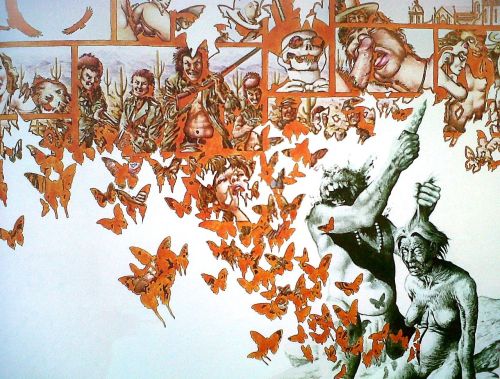
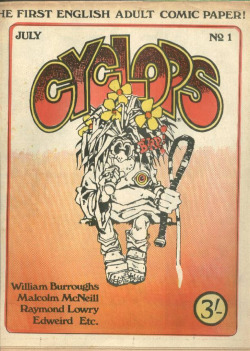
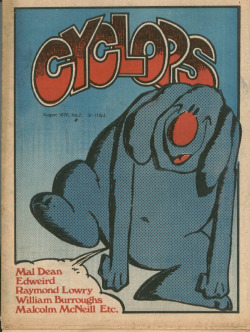


Art by Malcolm Mc Neill and a photograph of William S. Burroughs in Colombia. See more in Adrian Hill’s look into William S. Burroughs’s and Mc Neill’s collaboration, Ah Pook Is Here.
FALLING INTO PLACE (PART III)
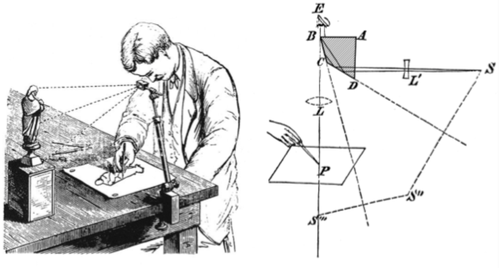
Camera Lucida in use. Optics of Wollaston Camera Lucida.
Adrian Hill on Malcolm Mc Neill and William S. Burroughs’s Ah Pook Is Here
The following is a three part exploration of Malcolm Mc Neill and William S. Burroughs’ word-image collaboration during the 1970s. This is part three. See part one here, and part two here.
Conversations with a Dead Man
AND YOU ASK ME why I do not believe in psychic events?
How can I not believe? you may ask given what I have seen, what I have learned.
And it occurs to me that I cannot provide for an adequate answer, because I do not believe the proper words exist for me to explain my agnosticism. You cannot know, therefore, and neither it seems can I.
—Charles Pellegrino, Titanic
In 1839-40, the American explorer John Stephens planned a trip traveling through Honduras and Guatemala, then north to the ancient ruins of Palenque. At the time, the Palenque ruins were the only remnants of ancient Mayan civilization known to exist. Stephens also returned to Central America to explore the Yucatan region in 1843. An artist named Frederick Catherwood (1799-1854) accompanied Stephens on both trips and provided the visual documentation of their travels.
When Malcolm Mc Neill first began researching the ancient Maya for image references, retrieving information was often a long, drawn-out process requiring trips to libraries or museums. He had stumbled upon drawings by Catherwood, but had no information about the artist. Nonetheless these drawings became inspiration for the realistic style used in the artwork for Ah Pook is Here. Catherwood used the camera lucida to accurately depict the ruins he drew, a technique that uses an optical lens to project a version of the image being drawn onto the artist’s paper in order to be traced.
Two books, Incidents of Travel in Central America, Chiapas and Yucatán (1841) and Incidents of Travel in Yucatán (1843), in addition to one watercolour folio, Views of Ancient Monuments in Central America, Chiapas and Yucatan, (1844) were published on the basis of the adventurers’ travels.
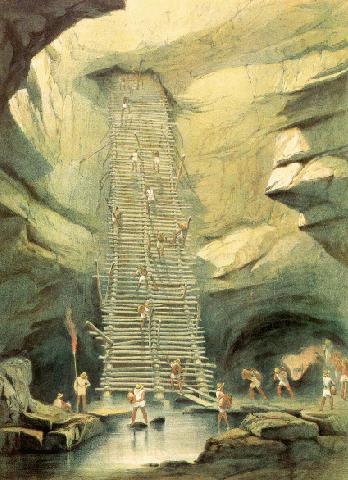
“Cenote Xtacumbilxunan, at Bolonchen, Yucatan” by Frederick Catherwood. First published in Views of Ancient Monuments in Central America, Chiapas and Yucatan.
It would be years later before Mc Neill would learn more about Catherwood. In 2003, Mc Neill decided spontaneously to look up information on Catherwood while conducting research at the Los Angeles County library. In 2003, Mc Neill discovered a biography of the artist called The Lost Cities of the Mayas: the Life, Art and Discoveries of Frederick Catherwood by Fabio Bourbon, which laid out a series of uncanny coincidences between Catherwood’s life and Mc Neill’s own:
…Frederick Catherwood was an English illustrator, and also of Scottish descent.
He also went to art school in London.
He also met an American writer who happened to be living in London at the time: John Lloyd Stephens.
Stephens had contacted Catherwood on the basis of his artwork and they too agreed to collaborate on a book together… about the Maya.
Catherwood met Stephens in Leicester Square. A few hundred yards down the road from Piccadilly where I met Bill. One “square” over, as it were…
It was an interesting discovery, but when it came down to it—so what? As I read on, however, the correspondences became so unlikely that they were hard to ignore.
Catherwood also moved to America to complete the work—and, just as I had—slightly ahead of his writer partner…
In Manhattan, his first home—like mine—was on Houston Street…
He also had a studio in Tribeca…
Like me, he moved from there to Prince Street…
We both had children born in New York, and both of us were separated from our wives there. His son, also born in December, was 6 years old at the time—as was mine…
We both quit illustration there …
He subsequently moved to California, where he too became an American citizen. He while living in Solano County, me while living in Solano Canyon…
As artists we shared a particular image style: panoramas. In New York we both became known for it. Catherwood through his panoramic murals, which he exhibited in his rotunda on Prince Street, myself through the panoramic images I created for television—while also living on Prince Street.
…Ultimately, Catherwood produced a folio edition of their collaboration and wrote an account of their history and friendship together….an account that had been published more than a century-and-a-half ago.
That I would be duplicating aspects of a dead man’s life was odd enough, but the nature of the coincidences and the manner in which they had been revealed evoked an even greater one (OWF, 107-108).
Recall the first two lines of Ah Pook is Here: “The Mayan codices are undoubtedly books of the dead; that is to say directions for time travel. If you see reincarnation as a fact, then the question arises; how does one orient oneself with regard to future lives?” The connection between the discovery of Catherwood and those two sentences was impossible to ignore. Had Mc Neill not recognized this coincidence, Observed While Falling would never have been written.
What are the chances? According to Burroughs’ theory of the word/image track and the existence of a pre-recorded script for reality, “There’s no such thing as a chance remark” (OWF, 108); the same would equally apply to all events.
On the basis of these coincidences, Mc Neill is led to the seemingly choiceless conclusion that Burroughs’ assumptions about predestination are valid. He does so, however, not as a victim of circumstance, but as an active agent in the determination of the predetermined, and not without acknowledging the level of incredulity that his disposition entails. Mc Neill is driven to further explore the tenuous fabric of this existence, simultaneously acknowledging, “The nature of the informational exchange may be impossible to explain, but its effects are impossible to ignore” (OWF, 147).
The resurrection of Ah Pook is Here led to Mc Neill’s establishing “a correspondence with a dead man” (OWF, 149). Ah Pook was once again present in Mc Neill’s life, and the lines between fact and fiction became blurred. In the absence of any clear direction regarding how to proceed, Mc Neill chose to follow his intuition. He decided to see where the first symbol that came to mind would lead him: jungle. The image was evocative of entanglement:
The fictional Hart and his friend Clinch Smith searched for the lost Mayan books in a jungle. In real life, on the other side of the so-called line, Catherwood and Stephens had ‘searched’ for their Mayan books in the very same jungle… in fact.
Both of these expeditions had resulted in books being found, one fictionally and literally, the other factually and figuratively” (OWF, 113).
What follows is a digression that explores not just these associations, but also an in-depth examination of the Mayan conception of time, among other topics. Mc Neill describes a series of novels as well as a television program in which scenes imagined by their authors bear a remarkable resemblance to events that eventually transpired in real life. The similarities are remarkable, and are presented as further fodder to support the “word/image track hypothesis.”
Mc Neill also explains how Ah Pook is Here predicted the methods of control practiced in the 21st century—the arsenal of surveillance techniques, news propaganda and police state fear-mongering present even in the most democratic of nations.
Next, Mc Neill expounds on the lunacy of the 2012 phenomenon, critiquing in particular the novel 2012: The War for Souls by Whitley Strieber, an acquaintance of Burroughs.
A comparison of Mayan and European conceptions of time ensues. The western mechanistic conception of time treats its progression as a chronologically relentless march into the future. In contrast, the Mayan conception of time is variable, relational and experiential, while still acknowledging the cyclical pattern of terrestrial seasons. Mc Neill likens it to the human heart:
[The heart] also marks time incrementally and is without doubt the measure of life. But the measure is qualitative in that each beat is a direct response to the context in which it occurs. The rhythm changes according to the way time is experienced. It’s both a barometer of time felt and an odometer measuring time spent. By implication, it’s also an indicator of time yet remaining—and it was this feature that may have held significance for the Maya (OWF, 123).
The “significance” to which Mc Neill alludes involves the symbolic value of human sacrifice in terms of time. Offering a human life before its natural demise may have been an appeal to the gods to disperse the future time of one individual among the many, for the benefit of the greater good. The sacrificial act served a dual purpose: on the one hand, it satiated the desires of the gods—but more importantly, it reinforced the mechanisms of societal control that allowed Mayan priests to continue exercising their reign.
In twenty-first century terms, the unwilling sacrifice of thousands of U.S. citizens with the destruction of the World Trade Center Towers on September 11, 2001 was also an exercise in control. The extreme violence of this act instilled an unprecedented fear in the general populace, the ultimate expression of Burroughs’ argument that “Time has no meaning without death. Death uses time” (APIHOT, 16).
Question: But, for what?
Answer: “For Control to control” (OWF, 125)—not through the imposition of order, but, conversely, through inciting chaos as a means of maintaining terror and bewilderment in the collective psyche of populations worldwide: in other words, to buy time.
Burroughs recognized a “quality of consideration…A meditation upon two models of time that resulted in a view seemingly existing outside of either” (OWF, 126) in the comparison of two dominant civilizations in human history, namely the Mayan and U.S. empires.
Mc Neill recognized a similar quality through juxtaposing two disparate personae in time: namely, Frederick Catherwood and himself.
Mc Neill recounts the early career of Catherwood, and then discusses the role of drawing out information through the act of drawing, through the writing process, and through experience. He recounts an extraordinary moment where, eighteen years after Mc Neill discussed with Burroughs visions he’d had as a child of an angry boy at the dinner table, his mother phoned him. She explained that his father had been previously married, and that his father’s first wife had borne a son, about whom Mc Neill had never had any knowledge. Mc Neill knew even before his mother finished her explanation what she was about to tell him.
Catherwood lived during a period in history where the threat of insurrection led the British monarchy to increase surveillance in the interests of maintaining state control and security. With the advent of the industrial revolution, women and children were hired as cheap labour, similar to the outsourcing of labour to “third world” and “developing” countries that happens today.
An increased war on crime and harsh techniques of imprisonment instituted by the government were widely introduced. The Methodists anticipated that the end of the world would arrive in 1836, and telecommunications exploded with the advent of the telegraph. Does any of this sound familiar? Plus ça change, plus c’est la même chose .
Dramatic association lines are drawn between the number 23 and its frequent presence in Mc Neill’s travels, concluding with his discovering a series of “newspaper clippings and odds and ends” (OWF, 144) in Box 23 of the Burroughs archive at Ohio State University. The artifacts found within this collection were a reminder of Burroughs’ concentrated interest in occult phenomena, and were a validation to Mc Neill that he was “on the right track.”
Burroughs is attributed with having been the first person to recognize the “23 phenomenon,” which suggests that at least some events are directly connected in some way with the number 23. As reported by Robert Anton Wilson in Fortean Times, Burroughs encountered a sailor named Captain Clark who boasted he’d sailed for 23 years without an accident. That day, Clark went sailing and died with all his passengers. Later the same day, Burroughs heard a radio announcement reporting that an airliner in Florida—Flight 23—also navigated by a Captain Clark, had crashed.
Through a friend, Mc Neill was led to encounter a psychic in the spiritualist community of Lily Dale, New York. Seemingly relevant information relayed through the medium with whom he was working suggested that a “mutual field of resonance” was being shared between the medium and Mc Neill. In a later consultation with another medium on the west coast, a similar shared association between the medium and Mc Neill apparently transpired. These events led to Mc Neill’s studying the practice of “another kind of attentiveness” in greater detail, leading to the realization of “remarkable insight” (OWF, 149).
Further to this subject, Mc Neill explained in a personal email correspondence:
It was a unique form of attentiveness that I found really fascinating since it opened a whole new sense of “Here”—specifically in the context of Death/Ah Pook. I went to Lily Dale simply because I was visiting my friend’s family nearby and she had suggested it…I attach no conventional “otherworldy” significance to the information conveyed by the mediums nor to the coincidences with Catherwood.
Catherwood’s presumed death in 1854 was as a victim of drowning from the sinking of the steamship the Arctic. As it travelled across the Atlantic Ocean, the ship collided with another in thick fog off the coast of Newfoundland. 282 passengers were aboard. Most of the women and children on the ship died; the Arctic’s crew took the lifeboats and left everyone else to perish. Mc Neill would discover later through independent research that there were only 23 reported survivors. Two months later, one empty lifeboat was discovered that had not been previously accounted for: “It was discovered by the schooner Lily Dale” (OWF, 147).
Mc Neill recounts how while waiting in an airport, he read Last Words by Burroughs for the first time. The last passage in Burroughs’ journal before his death made reference to the book Her Name, Titanic by Charles Pellegrino. Burroughs references page 18 from the book, which Mc Neill later discovers is a discussion of “telepresence.” Driven to find out more, Mc Neill reads a second book by Pellgrino on the subject, called Titanic. In this volume, he discovers, “Among those traveling aboard the Titanic were: a Mr. Burroughs, a Mr. John Hart, and yes—a Mr. Pook. All three of them drowned” (OWF, 153).
Where does time begin? When does it end? If we abandon the simple reference points of here and there, what are we left with? Time is now. Now where? Now here. Nowhere. Time extends to infinity, not just from the past into the future, but in every direction. It is available to us always, if we are prepared to receive it.
At this point, we have strayed far from the original trajectory having anything to do with comics. It is nonetheless important to ruminate on this aspect of Mc Neill’s story, if only to do justice to the entirety of his tale. Were it not for Gary Groth (co-founder of Fantagraphics Books) viewing Mc Neill’s artwork at the Track 16 Gallery in Los Angeles in 2009, it is possible that neither Observed While Falling nor The Lost Art of Ah Pook is Here would ever have been published. For Mc Neill, the resurrection of the artwork he created for Ah Pook is Here has everything to do with pursuing the Catherwood trail.
The tension residing at the heart of Mc Neill’s quest is quintessentially existential. What attracted me initially to Observed While Falling was Mc Neill’s commitment to exploring questions whose answers are “as impossible to explain as [they] are to dispute” (OWF, 146) without arriving at definitive conclusions. How did following this elusive trail change me? It brought me back. To where? That is precisely the question. That is exactly the point.
Observed While Falling is far more than a book about William Burroughs and Ah Pook is Here was a whole lot more than a comic book. The Ah Pook experience encapsulates a state of mind in which the full reservoir of time can be accessed at any moment. Ah Pook as the god of Death and regeneration was the vehicle for an exploration of that hypothesis. He escaped from the pages of his own book to take renewed form in a story about his story, thus perpetuating the cycle of death and rebirth throughout this life.
Adrian Hill works by day as a project manager for an educational publishing house. He infrequently maintains a blog called Graphically Inclined, where he writes mostly about comics. He lives in Victoria, British Columbia.


